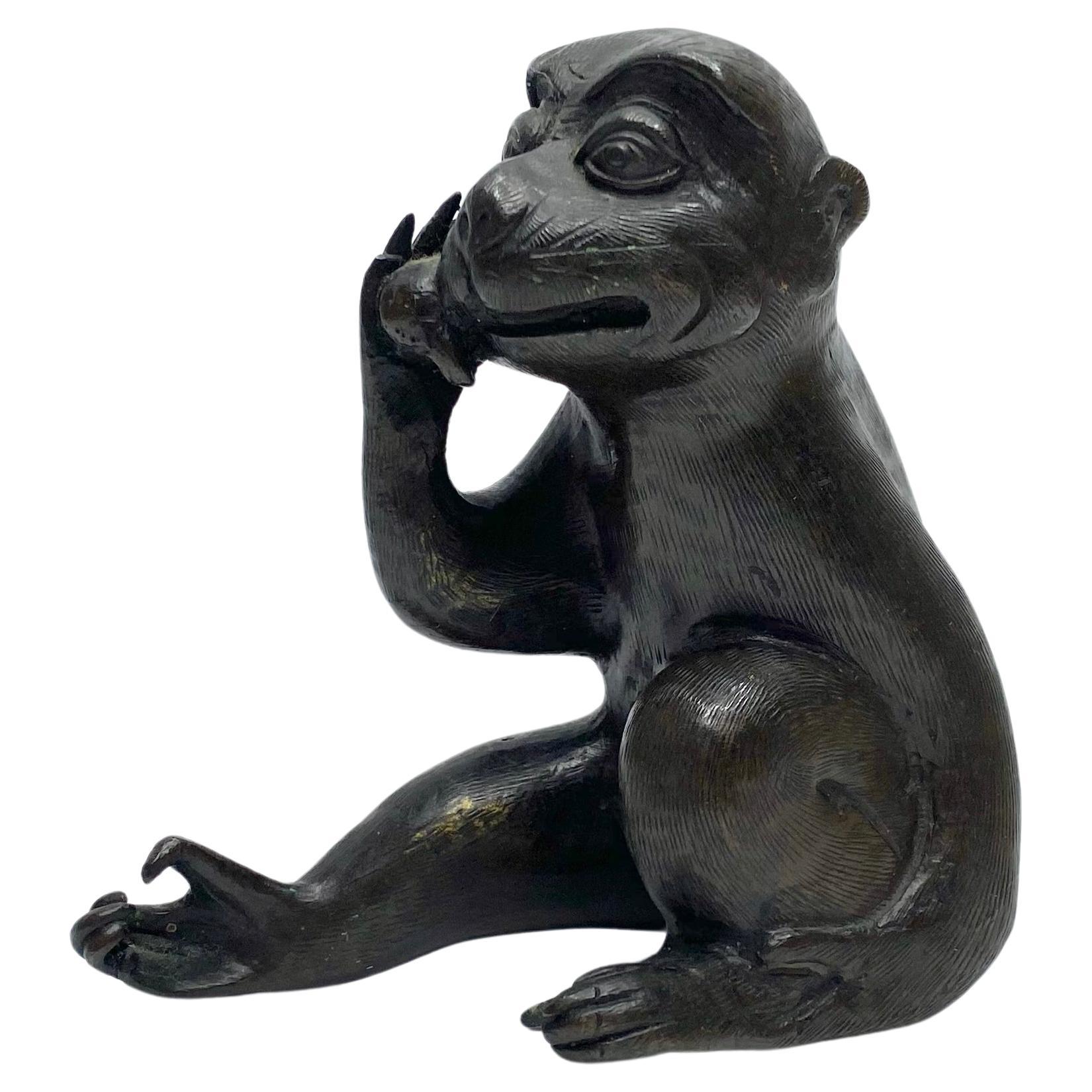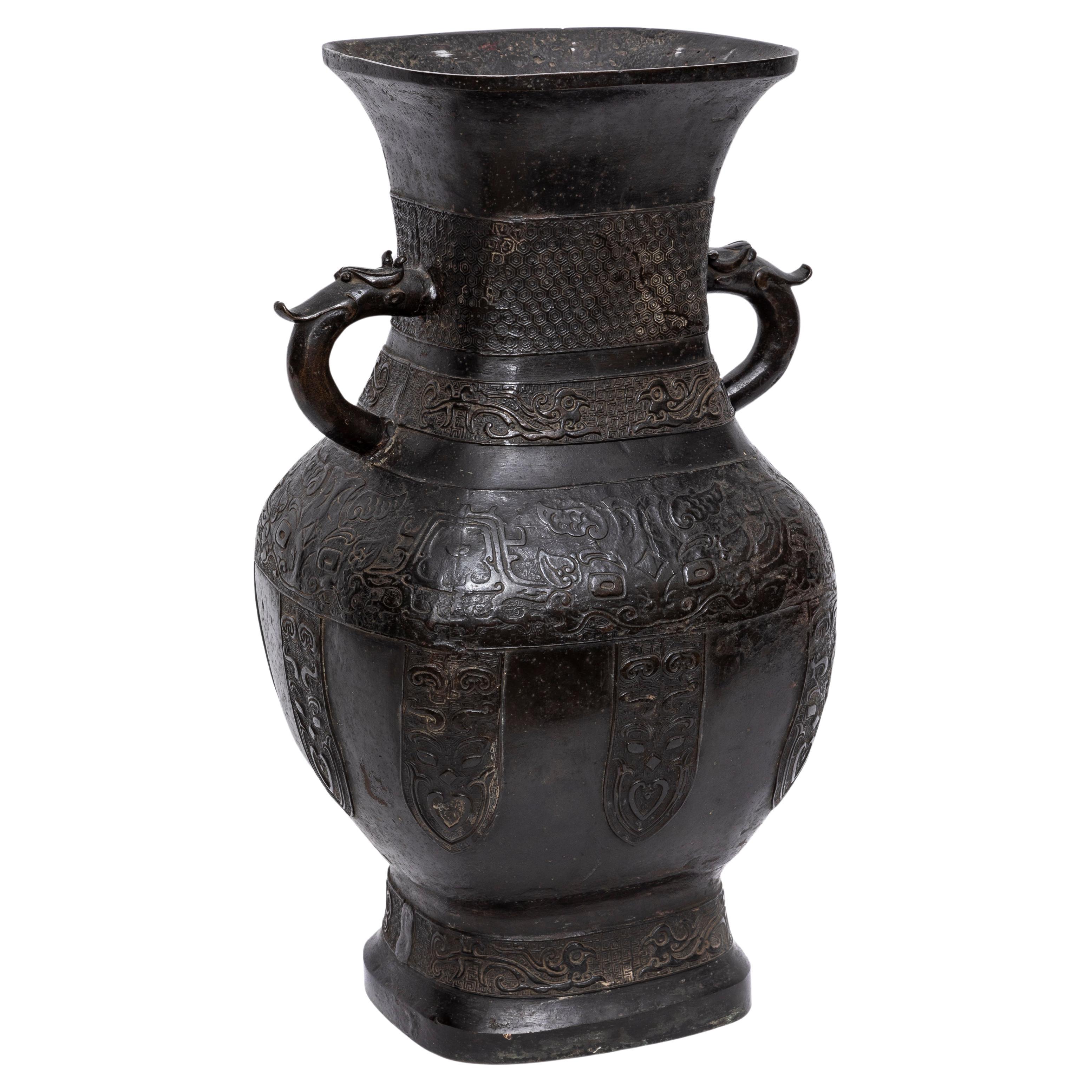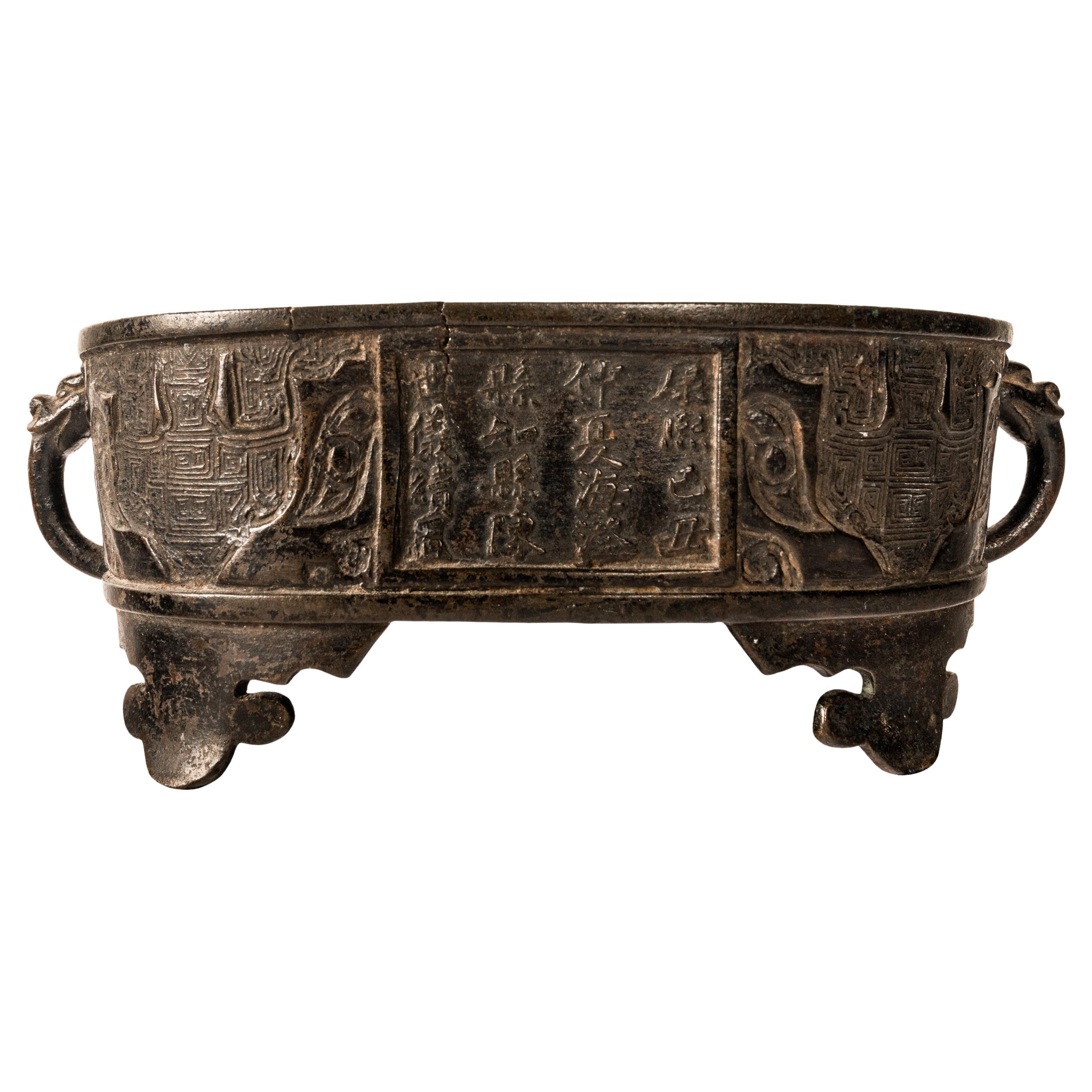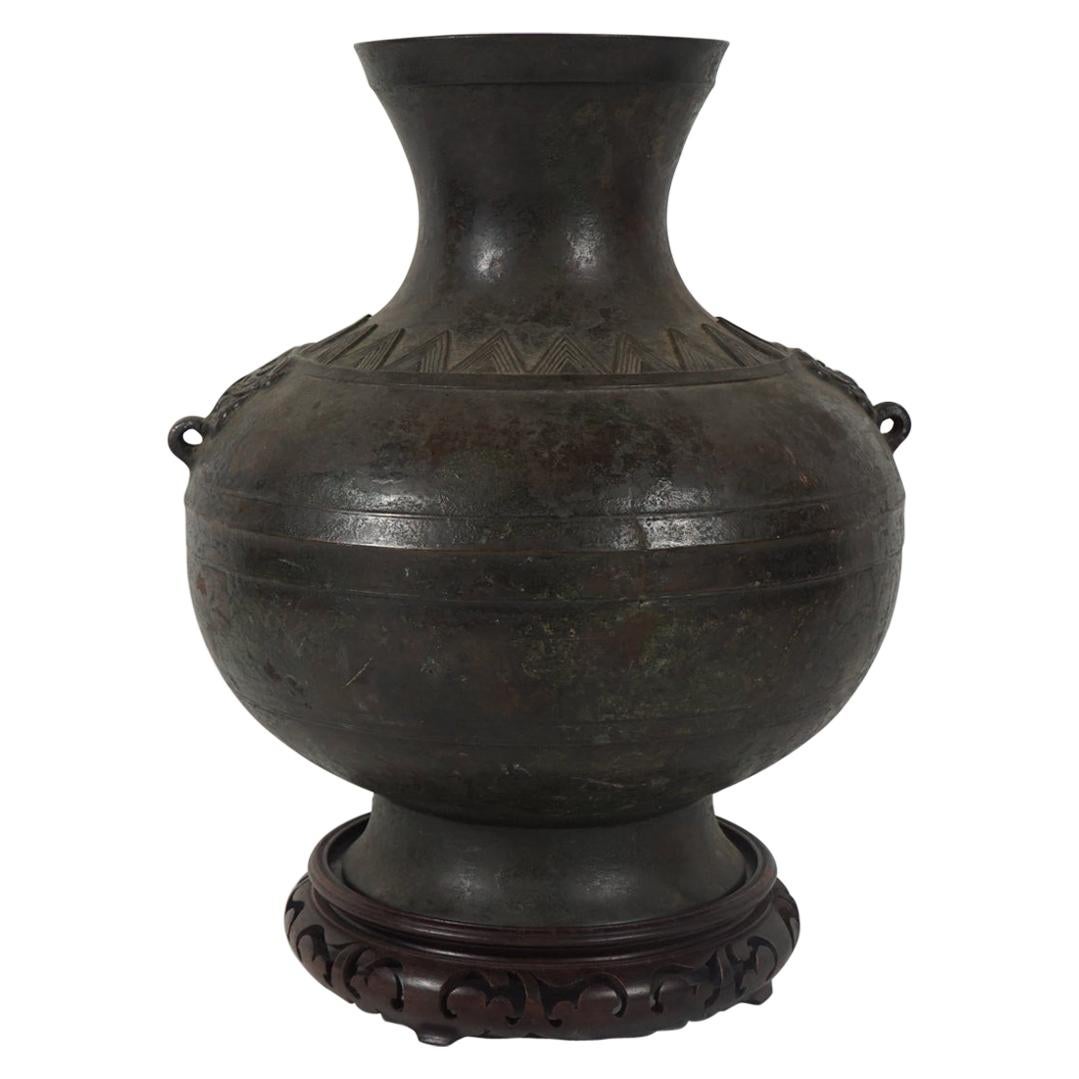Items Similar to Chinese Ming Dynasty Bronze Buddha of the future Maitreya
Want more images or videos?
Request additional images or videos from the seller
1 of 11
Chinese Ming Dynasty Bronze Buddha of the future Maitreya
About the Item
Chinese Ming Dynasty period bronze figure of Bodhisattva of the future - Maitreya.
It is beautifully modeled in fine details typical of high-quality casting done in the Ming dynasty (1368-1644).
The Bodhisattva is seated on a double-lotus base, legs folded with soles of feet facing up. The folds of his dhoti gently laying. His thin waist and belly is realistically modeled. His hands are in the teaching mudra while holding two lotus stems: one supports a water flask and the other a sacred sutra. His face is round with full lips, long nose, high arched brows displaying a gentle smile with radiant confidence. He wears large round earrings on his elongated earlobes and his hair is in a top knot. He wears a jeweled crown.
It comes with good provenance having been collected by the 1950.
Mrs. Porter, Rockport, Massachusetts, collected before 1950s.
- Dimensions:Height: 7.25 in (18.42 cm)Width: 5 in (12.7 cm)Depth: 3.25 in (8.26 cm)
- Style:Ming (Of the Period)
- Materials and Techniques:Bronze,Metalwork
- Place of Origin:
- Period:
- Date of Manufacture:circa 17th century
- Condition:Wear consistent with age and use. Minor losses. Beautiful original brown patina. Crown missing two points. The back bottom of the lotus base is slightly uneven. missing the base plate.
- Seller Location:San Francisco, CA
- Reference Number:1stDibs: LU7756239651842
About the Seller
5.0
Vetted Seller
These experienced sellers undergo a comprehensive evaluation by our team of in-house experts.
1stDibs seller since 2022
Typical response time: 5 hours
- ShippingRetrieving quote...Ships From: San Francisco, CA
- Return PolicyA return for this item may be initiated within 3 days of delivery.
More From This SellerView All
- Japanese Impressionist Painting of Trees in Snow By S Kitayama Dated 1912By Japanese StudioLocated in San Francisco, CAAn impressionist painting of a trees in snow on a wooden board in period carved gilded frame. It is signed on the bottom right hand corner S Kitayama and dated 1912. Further inscription in Kanji on the back of the frame. Frame measures 17 x 20 1/2 inches Painting measures 9 1/4 x 12 3/4 inches Frame is original to the painting and of the period. The painter is most likely Seitaro Kitayama (Japanese, 1888-1945), an important figure in late Meiji period credited with being the father of Japanese animation before Walt Disney started his company. The painting style is impressionism which was keenly followed by a new generation of Japanese artists who either traveled to Europe for training or received Western publications on artists and gallery shows at home. Kitayama, Seitaro was born on March 3, 1888 in Wakayama, and died on February 13, 1945. In 1911, Kitayama became an apprentice to Tojiro Oshita and, while studying painting, also helped out with editing the art magazine Mizue. He soon moved to Tokyo and established the Western Art Guild of Japan and published Contemporary Western Art. He later joined the Fusain Art Group as a manager where he would support young western-style artists such as Ryusei Kishida and Sohachi Kimura by providing art supplies, in addition to holding exhibitions and publishing catalogues. On the other hand, he entered the Nikkatsu Mukojima Studio in 1916, proposed the inclusion of illustrations in intertitles, and made this his work. It was there that one of the first Japanese animations...Category
Vintage 1910s Japanese Modern Paintings and Screens
MaterialsPaint, Acrylic
- Japanese Modernist Painting of a Seaside Village by Torao Ataka Dated 1930By Japanese StudioLocated in San Francisco, CAA Modern oil painting of a harbor town with the water and mountains views in the distance. It is signed on the bottom left hand corner Ataka and dated '30 (1930). The brushwork is ...Category
Vintage 1930s Japanese Modern Paintings and Screens
MaterialsCanvas, Paint
- Japanese Expressionist Painting of a Sea View from a Balcony by Yoshio AoyamaBy Japanese StudioLocated in San Francisco, CAAn expressionist oil painting of a seaside view from a balcony in carved gilded frame. It is signed on the bottom right hand corner Aoyama. Signed Aoyama circa 1960s-1970s Frame measures 16 x 19 1/4 inches Painting measures 9 1/2 x 13 inches This painting is likely a scene from the French Riviera or Cote d'Azur. Yoshio Aoyama...Category
Late 20th Century Japanese Modern Paintings and Screens
MaterialsAcrylic, Paint
- Antique Indian Miniature Painting of Lovers Krishna & Radha, Circa 19th CenturyLocated in San Francisco, CAA charming painting of Lord Krishna and his paramour Radha painted in mineral pigments (gouache) with gold and silver highlights circa mid 19th century in Jaipur style of painting. Krishna was a god (an incarnation of god Vishnu) who accomplished great feats and defeated insurmountable demons. However, he is also considered the most playful amongst gods and an epic lover of godly proportions. His love story with Radha (a married woman) has been the subject of much poetry and worship for centuries as it symbolized the divine love. Here, the lovers are depicted in a loving embrace offering one another a lotus flower. Radha is often depicted hopelessly resisting Krishna's advances as in this painting. The couple's heads are circled by a halo, signifying their divinity. The setting is typical of the interior modeling in the 19th century with use of heavy curtains...Category
Antique Mid-19th Century Indian Paintings and Screens
MaterialsAcrylic
You May Also Like
- Chinese bronze Monkey, 17th Century, Ming Dynasty.Located in Gargrave, North YorkshireChinese bronze figure of a Monkey, 17th Century, Ming Dynasty. The amusing study, cast as a seated monkey, about to devour a peach, held in his right hand. His hair well delineated, ...Category
Antique 17th Century Chinese Ming Metalwork
MaterialsBronze
- A Ming Dynasty Patinated Bronze Relief Work Vase Turned to a LampLocated in New York, NYHailing from the Ming period in 16/17th century, this monumental bronze vase is a fine example of the auspicious decor and markings unique to Chinese furnishings. The vase is cast wi...Category
Antique 17th Century Chinese Ming Metalwork
MaterialsBronze
- Chinese Bronze Scholar Vase with Taotie, Ming/Qing Dynasty, 17th century, ChinaLocated in Austin, TXA small and interesting cast bronze archaistic scholar vase with loose ring handles and taotie mask design, late Ming or early Qing Dynasty, mid 17th century, China. The small vase of archaistic hu form, and cast with archaistic designs. Sitting on a tall splayed ring foot, the round body is cast with a large band featuring a ferocious taotie (ogre) mask. The taotie mask in this case id decidedly feline, with a ruyi shaped snout above a whiskered mouth. Two flanges stick out to either side of the mask, reminiscent of ears. A wide, tall neck rises from the body, terminating in a slightly everted mouth. The archaistic cast design on the neck is not as clear, but most likely represents Fusang, a mythical island in the Eastern Sea where the legendary Fusang tree grows. The Fusang tree, home to the mythical Sun Bird...Category
Antique Mid-17th Century Chinese Qing Scholar's Objects
MaterialsBronze
- Antique Archaic Zhou Dynasty Style Chinese Bronze Censer Incense Burner MingLocated in Portland, ORA good antique Chinese Zhou dynasty style archaistic bronze censer, incense burner. This cast bronze censer is in the archaic Zhou dynasty style, but believed to be more likely from ...Category
Antique 17th Century Chinese Archaistic Metalwork
MaterialsBronze
- Ming Dynasty Bronze Figure of the Infant BuddhaLocated in Austin, TXA rare and unusual Chinese Ming Dynasty bronze figure of the Buddha as an infant. The young Prince Siddhartha, who would grow up to become the Buddha, is portrayed standing, one hand pointing to the sky, the other to the ground. He is naked, save for a baby apron...Category
Antique 16th Century Chinese Ming Sculptures and Carvings
MaterialsBronze
- Ming Dynasty Period Cast Bronze Hue Shaped Urn in an Archaist StyleLocated in Hudson, NYThis fine old urn cast as an honorific nod to the ancient past of China was made circa 1600-1650. The shape or Hue was a common and well-represented form in the Han dynasty in pottery and bronze. This urn shows thin casting to the walls with incorporated toe tia or facial masks...Category
Antique Mid-17th Century Chinese Ming Metalwork
MaterialsBronze
Recently Viewed
View AllMore Ways To Browse
Antique Bronze Furniture Legs
Antique Thins
Antique Castings
Antique Bronze Chinese
Antique Chinese Bronze China
Chinese Ming Dynasty
Chinese Ming Dynasty Furniture
Antique High Hair
Ming Dynasty Antique
Antique Ming Dynasty
Bronze Arch
Bronze Buddha
Ming Period
Bronze Knot
Model Arch
Dynasty Fine China
Chinese Arch
Ming Large





